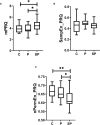Changes in the autonomic cardiorespiratory activity in parturient women with severe and moderate features of preeclampsia
- PMID: 37724103
- PMCID: PMC10505439
- DOI: 10.3389/fimmu.2023.1190699
Changes in the autonomic cardiorespiratory activity in parturient women with severe and moderate features of preeclampsia
Abstract
Background: Cardiorespiratory coupling (CRC) is a physiological phenomenon that reflects the mutual interaction between the cardiac and respiratory control systems. It is mainly associated with efferent vagal activity from the central autonomic network. Few studies have explored the autonomic changes of CRC in preeclampsia, a critical obstetric complication related to possible autonomic dysfunctions and inflammatory disturbances. This study examined the autonomic mechanisms of CRC in women with severe and moderate preeclampsia and healthy controls by applying nonlinear methods based on information theory, such as mutual information (MI) and Renyi's mutual information (RMI) and the linear and nonlinear analysis of the Pulse-Respiration Quotient (PRQ).
Methods: We studied three groups of parturient women in the third trimester of pregnancy with a clinical diagnosis of preeclampsia without severe symptoms (P, 38.5 ± 1.4 weeks of pregnancy, n=19), preeclampsia with severe symptoms (SP, 37.5 ± 0.9 weeks of pregnancy, n=22), and normotensive control women (C, 39.1 ± 1.3 weeks of pregnancy, n=20). 10-minutes of abdominal electrocardiograms (ECG) and respiratory signals (RESP) were recorded in all the participants. Subsequently, we obtained the maternal beat-to-beat (RR) and breath-to-breath (BB) time series from ECG and RESP, respectively. The CRC between RR and BB was quantified by nonlinear methods based on information theory, such as MI and RMI, along with the analysis of the novel index of PRQ. Subsequently, we computed the mean PRQ (mPRQ) and the normalized permutation entropy (nPermEn_PRQ) from the PRQ time series generated from BB and RR. In addition, we examined the vagal activity in the three groups by the logarithm of the median of the distribution of the absolute values of successive RR differences (logRSA).
Results: The MI and RMI values were significantly lower (p<0.05) in the preeclamptic groups compared to the control group. However, no significant differences were found between the preeclamptic groups. The logRSA and nPermEn_PRQ indices were significantly lower (p<0.05) in SP compared to C and P.
Conclusion: Our data suggest that parturient women with severe and mild preeclampsia may manifest an altered cardiorespiratory coupling compared with normotensive control women. Disrupted CRC in severe preeclampsia could be associated with vagal withdrawal and less complex cardiorespiratory dynamics. The difference in vagal activity between the preeclamptic groups may suggest a further reduction in vagal activity associated with the severity of the disease.
Keywords: cardiorespiratory coupling; mutual information; pregnancy; pulse-respiration quotient; vagal withdrawal.
Copyright © 2023 Pichardo-Carmona, Reyes-Lagos, Ceballos-Juárez, Ledesma-Ramírez, Mendieta-Zerón, Peña-Castillo, Nsugbe, Porta-García and Mina-Paz.
Conflict of interest statement
The authors declare that the research was conducted in the absence of any commercial or financial relationships that could be construed as a potential conflict of interest.
Figures





Similar articles
-
Diabetes alters cardiorespiratory dynamics: insights from short-term recurrence quantification analysis of pulse-respiration quotient.Front Physiol. 2025 Apr 25;16:1584922. doi: 10.3389/fphys.2025.1584922. eCollection 2025. Front Physiol. 2025. PMID: 40352153 Free PMC article.
-
Maternal cardiac autonomic function and fetal heart rate in preeclamptic compared to normotensive pregnancies.Can J Cardiovasc Nurs. 2005;15(3):42-52. Can J Cardiovasc Nurs. 2005. PMID: 16295797
-
Pulse respiration quotient as a measure sensitive to changes in dynamic behavior of cardiorespiratory coupling such as body posture and breathing regime.Front Physiol. 2022 Dec 23;13:946613. doi: 10.3389/fphys.2022.946613. eCollection 2022. Front Physiol. 2022. PMID: 36620213 Free PMC article.
-
Preeclampsia: an update.Acta Anaesthesiol Belg. 2014;65(4):137-49. Acta Anaesthesiol Belg. 2014. PMID: 25622379 Review.
-
The Pulse-Respiration Quotient: A Powerful but Untapped Parameter for Modern Studies About Human Physiology and Pathophysiology.Front Physiol. 2019 Apr 9;10:371. doi: 10.3389/fphys.2019.00371. eCollection 2019. Front Physiol. 2019. PMID: 31024336 Free PMC article. Review.
Cited by
-
Analysis of fetal heart rate fluctuations in women diagnosed with preeclampsia during the latent phase of labor.Front Physiol. 2024 May 23;15:1340441. doi: 10.3389/fphys.2024.1340441. eCollection 2024. Front Physiol. 2024. PMID: 38846420 Free PMC article.
-
Diabetes alters cardiorespiratory dynamics: insights from short-term recurrence quantification analysis of pulse-respiration quotient.Front Physiol. 2025 Apr 25;16:1584922. doi: 10.3389/fphys.2025.1584922. eCollection 2025. Front Physiol. 2025. PMID: 40352153 Free PMC article.
References
Publication types
MeSH terms
LinkOut - more resources
Full Text Sources
Medical

